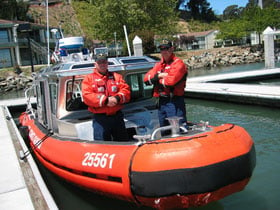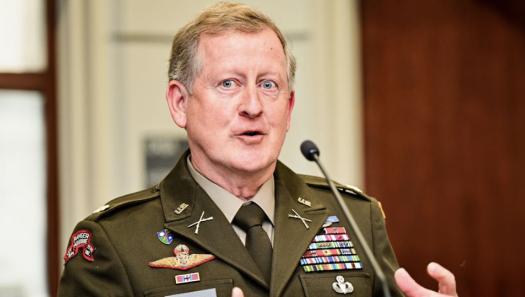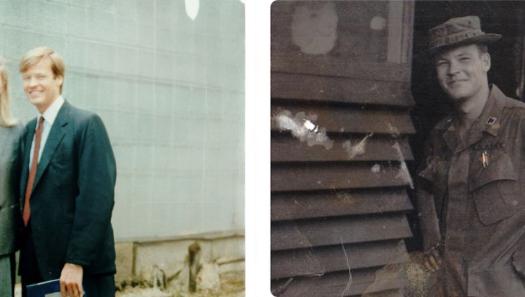Military & Veterans News
Vet News: Coast Guard Celebrates 215 Years of Securing Homeland
Donna Miles, American Forces Press Service

SAN FRANCISCO, Aug. 4, 2005 – The 25-foot-long vessel bounced over the whitecaps on San Francisco Bay, propelled by 450 horsepower of thrust as it approached the majestic span that’s become this city’s internationally known symbol.
There, below the Golden Gate Bridge, Coast Guard Petty Officer 1st Class Jason Gale and Seaman Marcel Gradvohl began inspecting the bridge’s piers, abutments, fenders and pilings for signs of tampering or intrusion, and ensuring that no people or watercraft had violated the 25-yard security zone around the structures.
 Gale and Gradvohl, both assigned to Coast Guard Station Golden Gate, are on the front lines of the Coast Guard’s homeland defense mission, helping protect the nation’s critical maritime infrastructure against terrorist attack. They’re part of a Coast Guard-wide effort that protects more than 361 ports and 95,000 miles of coastline along the United States’ longest border.
Gale and Gradvohl, both assigned to Coast Guard Station Golden Gate, are on the front lines of the Coast Guard’s homeland defense mission, helping protect the nation’s critical maritime infrastructure against terrorist attack. They’re part of a Coast Guard-wide effort that protects more than 361 ports and 95,000 miles of coastline along the United States’ longest border.
The homeland defense mission is nothing new to the Coast Guard. Although it may be more visible to many since the terrorist attacks of Sept. 11, 2001, it’s been a major Coast Guard mission since the federal government established the Coast Guard 215 years ago today as the country’s first maritime service.
Adm. Thomas H. Collins, Coast Guard commandant, set the tone for the priority homeland defense would receive as the service prepared to become part of the new Department of Homeland Security. "While all the missions of the Coast Guard remain vital, homeland security is at the forefront," Collins wrote in an open letter to the Coast Guard.
More than two years later, here on the California coast, the Coast Guard is carrying out Collins’ directive 24/7 with regular security patrols, vessel escorts and ship container inspections.
The Coast Guard’s presence here dates back to 1848, when it dispatched the Revenue Cutter Lawrence here to maintain maritime order during the California gold rush.
Today, Coast Guard Group San Francisco, with three of its seven stations inside San Francisco Bay, carries out missions ranging from enforcing maritime law to ensuring marine safety to maintaining aids to navigation. But the bulk of the group’s time and energy goes into the almost 3,000 search-and-rescue missions it conducts every year -- the largest number in the Coast Guard -- and its lower-profile but equally important homeland defense mission.
This includes protecting the Golden Gate Bridge, the Oakland-San Francisco Bay Bridge, the Port of Oakland, and the 350 square miles of San Francisco Bay.
Spanish law enforcement authorities confirmed the importance of the mission when they arrested three suspected al Qaeda members in July 2002. The suspects had homemade videotapes that gave what authorities called "substantial attention" to the Golden Gate Bridge, along with other U.S. landmarks, including pre-attack footage of New York’s World Trade Center.
Lt. Leanne Bacon, assistant operations office for Coast Guard Group San Francisco, explained that the Golden Gate Bridge is far more than a national icon. It’s the gateway to San Francisco, a major U.S. metropolitan city and tourist area, and the Port of Oakland, the country’s fourth-busiest port. And because the Golden Gate provides a vital transportation link to the region, any attack on it would have severe, possibly long-term economic impact.
Recognizing these realities gives members of Coast Guard Group San Francisco a sense of purpose as they carry out their mission. They patrol the bay day and night in their RBSs, or "response boats, small," fast-moving, agile vessels with built-in weapons mounts that were added to the Coast Guard fleet nationwide after the Sept. 11, 2001, attacks to support homeland defense missions.
In addition to looking for suspicious activity, the Coast Guardsmen provide regular escorts for many higher-profile vessels entering, transiting, anchoring or mooring in San Francisco Bay. Coast Guard members meet incoming commercial vessels at the pilot’s station 13 miles outside the bay’s mouth, sending boarding teams to the vessels to check their passenger and cargo manifests against what they find onboard, Bacon explained. They also partner with Border Patrol agents to search specified ship containers.
And as vessels transit the bay, the Coast Guard enforces security zones designed to protect them from attack. Cruise ships, ferries and large commercial ships get a 100-yard security zone around them, Gale said. Navy and Military Sealift Command ships get a 500-yard security zone.
Speeding around San Francisco Bay on his RBS, Gale, a third-generation Coast Guardsman, described the changes he’s witnessed during his 14 years of service. Homeland security now ranks right up with search -and rescue in emphasis, assets assigned and missions conducted.
Units spend more time under way running more patrols, always armed with automatic weapons and side arms, he said.
"(The Coast Guard has) never been as law-enforcement oriented as it is today," Gale said. "It’s almost like I joined a fire department and now I’m a police officer, too."
With just three years of Coast Guard service under his belt, Gradvohl hasn’t seen as vast a transformation in Coast Guard focus, but he, too, notices that the operational tempo continues to climb. The result, he said, is a highly trained force of professionals that’s able to carry out whatever mission the Coast Guard calls on them to perform.
Chief Petty Officer Gabe Flesher, search-and-rescue and homeland security coordinator for Coast Guard Group San Francisco, said he recognizes the important role the Coast Guard is playing in keeping San Francisco Bay secure. "You know that just by your presence, people feel safer," he said. "They know we’re there looking out for them."
And there’s a lot of satisfaction in helping give people a sense of security and peace of mind ‘so they can go on with their day-to-day lives and live without fear," Flesher said. "That’s the gratification of what we do."
Collins said the Coast Guard has been bringing people that sense of security throughout its history. "Since 1790, the Coast Guard has been America’s maritime ‘first responder,’" patrolling the country’s river systems, ports, coastlines and the high seas, he said. "We have been serving as the nation’s first line of defense, preventing threats from reaching the nation and responding to any maritime event."
And as part of the United States’ homeland security and defense team, Collins said, the Coast Guard continues to work day in and day out to protect American lives, infrastructure and economy. New programs and practices implemented since 9/11 have made the United States maritime transportation system safer today and "are already paying huge dividends," he said.
"As our nation’s oldest continuous maritime service, we take great pride in our 215-year history of operational excellence," he said.
Collins is quick to credit the men and women of the Coast Guard for establishing and continuing to build on that record. "Our people are the reason for every one of our successes, as they routinely put service above self," he said.
SOURCE: VNIS - American Forces Press Service


